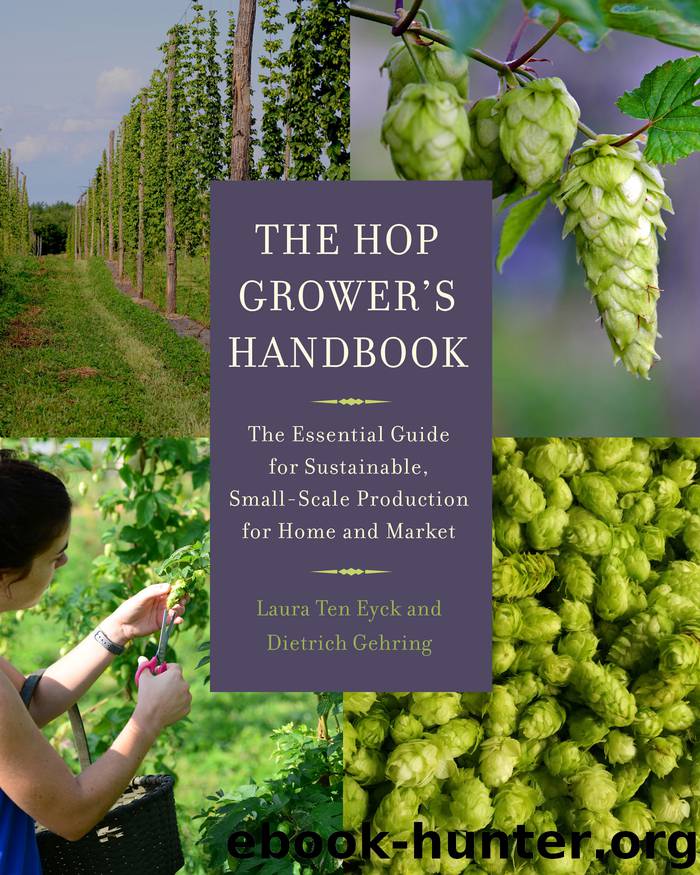The Hop Grower's Handbook by Laura Ten Eyck

Author:Laura Ten Eyck
Language: eng
Format: epub
Publisher: Chelsea Green Publishing
Published: 2016-05-18T16:00:00+00:00
This Cascade hop growing in our garden is twenty-eight years old. It was originally planted by the barn, then transplanted to the garden next to the house, and ultimately to the vegetable garden where it grows today.
It is often said that monocultures are always manmade and do not exist in nature, but this is not necessarily the case. Sometimes in nature, under specific conditions, one species of animal or plant will take over a place. Think huge stands of reeds waving in a breezy marshland. Or savannahs where one kind of grass, such as wild sorghum, overpowers the others. When conditions change and the population becomes unsustainable, it crashes— and that’s okay because it is just nature taking its course. In the wild, other species arrive over time to fill the niche and heal the ecosystem. But if you’re selling what you grow, you need to make sure it can keep growing.
Monocultures attract insects and diseases that thrive on that particular crop because of the plentiful food source. When they arrive, they can reach epic proportions and destroy your entire crop. As a farmer trying to make a living, you really do not want nature to take its course because it means you will lose everything you have worked for. Although sometimes it doesn’t seem like it, people are part of nature, too, and it is natural to want to defend your livelihood. But in doing so, humans have made some mistakes—big ones.
Fortunately, though, we are finally coming to realize that simply blasting insects and diseases with highly toxic chemicals does not work in the long run. By applying an abundance of toxic chemicals to our crops we not only pollute our environ ment, damaging the health of numerous life forms, including our own, but we also improve the resiliency of the very species we are trying to kill. When we plant a crop that a particular disease or insect likes, then spray that crop with a toxic chemical to destroy that insect or pathogen, we create an environment in which that pathogen or insect is highly motivated to develop a resistance to the chemical so that it can keep taking advantage of the food source.
Download
This site does not store any files on its server. We only index and link to content provided by other sites. Please contact the content providers to delete copyright contents if any and email us, we'll remove relevant links or contents immediately.
Turbulence by E. J. Noyes(7942)
The Thirst by Nesbo Jo(6832)
Gerald's Game by Stephen King(4584)
Be in a Treehouse by Pete Nelson(3953)
Marijuana Grower's Handbook by Ed Rosenthal(3623)
The Sprouting Book by Ann Wigmore(3544)
The Red Files by Lee Winter(3368)
The Remains of the Day by Kazuo Ishiguro(3295)
Sharp Objects: A Novel by Gillian Flynn(2958)
Christian (The Protectors Book 1) by L. Ann Marie(2656)
Organic Mushroom Farming and Mycoremediation by Tradd Cotter(2631)
The Culinary Herbal by Susan Belsinger(2433)
Stone Building by Kevin Gardner(2353)
The Starter Garden Handbook by Alice Mary Alvrez(2285)
Lilac Girls by Martha Hall Kelly(2258)
The Unlikely Pilgrimage of Harold Fry by Rachel Joyce(2221)
The Lean Farm Guide to Growing Vegetables: More In-Depth Lean Techniques for Efficient Organic Production by Ben Hartman(2099)
Urban Farming by Thomas Fox(2063)
Backyard Woodland by Josh VanBrakle(1895)
